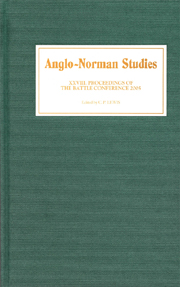Book contents
- Frontmatter
- Contents
- LIST OF ILLUSTRATIONS, MAPS, AND TABLES
- EDITOR'S PREFACE
- ABBREVIATIONS
- Inside the Anglo-Norman Family: Love, Marriage, and the Family (R. Allen Brown Memorial Lecture)
- Land Tenure and Royal Patronage in the Early English Kingdom: A Model and a Case Study
- The Homilies of a Pragmatic Archbishop's Handbook in Context: Cotton Tiberius A. iii
- Robert de Vaux and Roger de Stuteville, Sheriffs of Cumberland and Northumberland, 1170–1185
- The Common Steeple? Church, Liturgy, and Settlement in Early Medieval Lincolnshire
- The Question of Masculinity in William of Malmesbury's Presentation of Wulfstan of Worcester
- Share and Share Alike? Bishops and their Cathedral Chapters: The Domesday Evidence
- Dunstan and Monastic Reform: Tenth-Century Fact or Twelfth-Century Fiction?
- Domesday Now
Inside the Anglo-Norman Family: Love, Marriage, and the Family (R. Allen Brown Memorial Lecture)
Published online by Cambridge University Press: 12 September 2012
- Frontmatter
- Contents
- LIST OF ILLUSTRATIONS, MAPS, AND TABLES
- EDITOR'S PREFACE
- ABBREVIATIONS
- Inside the Anglo-Norman Family: Love, Marriage, and the Family (R. Allen Brown Memorial Lecture)
- Land Tenure and Royal Patronage in the Early English Kingdom: A Model and a Case Study
- The Homilies of a Pragmatic Archbishop's Handbook in Context: Cotton Tiberius A. iii
- Robert de Vaux and Roger de Stuteville, Sheriffs of Cumberland and Northumberland, 1170–1185
- The Common Steeple? Church, Liturgy, and Settlement in Early Medieval Lincolnshire
- The Question of Masculinity in William of Malmesbury's Presentation of Wulfstan of Worcester
- Share and Share Alike? Bishops and their Cathedral Chapters: The Domesday Evidence
- Dunstan and Monastic Reform: Tenth-Century Fact or Twelfth-Century Fiction?
- Domesday Now
Summary
The Director will, I hope, recall his jesting response when I first suggested this topic to him: ‘I assume there is something to be said about it.’ The ill-informed will impute sarcasm: better-educated persons who know that Victoria County History editors have to be expert in every period of English history from Roman Britain to the present will recognize knowledge and good sense. Most of the sources to which scholars of the early modern or modern periods would immediately turn for enlightenment on the subject of family love – wills, ecclesiastical court depositions, diaries, autobiographies, biographies, private correspondence, from the eighteenth century onwards newspapers – are of course absent in our period. By contrast the Anglo-Norman period must indeed seem both loveless and unlovely: remember Sir Frank Stenton's famous closing denunciation: ‘The Normans who entered into the English inheritance were a harsh and violent race. They were the closest of all western peoples to the barbarian strain in the continental order.’ And myths about the historical family abound: one, that the family in the past was a much larger entity than the modern nuclear family, I have tried to demolish here on another occasion. Linked to that myth is another, that the family in the past was loveless, brought into being by an arranged marriage, insulated from parental love by high infant and child mortality (which, alas, is a fact), so that parents would delay investing in love lest their children die.
- Type
- Chapter
- Information
- Anglo-Norman Studies 28Proceedings of the Battle Conference 2005, pp. 1 - 18Publisher: Boydell & BrewerPrint publication year: 2006



